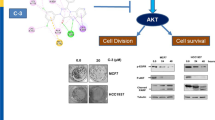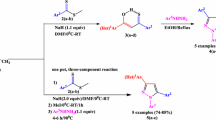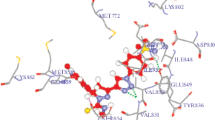Abstract
A novel series of new di-(N-piperazin-1-yl)amidrazones and related congeners (3a–s) was synthesized by reaction of Nʹ,Nʺ-(biphenyl-4,4ʹ-diyl)-bis(2-oxopropanehydrazonoyl chloride) (2) with a selected set of secondary amines in basic media. Structures of the newly synthesized compounds were confirmed by elemental analysis and by various spectroscopic techniques such as 1H NMR, 13C NMR, 2D-NMR, and ESI-HRMS spectral data. Prepared compounds have been screened for antitumor activity against different cancer cell lines including breast cancer (MCF-7), colon cancer (Caco-2), and Leukemia (K562) cell lines using the tetrazolium dye 3-(4,5-dimethylthiazol-2yl)-2,5-diphenyltetrazolium bromide (MTT) cell viability assay. Although with varying degrees, a significant growth inhibitory and cytotoxic effect was observed on all three cancer cell lines. Compounds 3a, 3b, 3c, 3d, and 3m, showed significant growth inhibitory and cytotoxic effect against the aforementioned cancer cell lines. Glide docking studies against PI3Kα demonstrated that some structural analogues accommodate PI3Kα kinase domain and bind to Ser774, Ala775, Glu798, Lys802, Tyr836, Val851, Asn853, Thr856, Gln859, Ser919, and Asp933. Additionally, part of the backbones of prepared compounds fit the pharmacophoric features of PI3Kα active inhibitors.





Similar content being viewed by others
References
Abadleh MM, El-Abadelah MM, Sabri SS, Mohammed HH, Zihlif MA, Voelter W (2014) Synthesis and antitumor activity of some N2-(Thien-3-yl) amidrazones. Z Naturforsch B Chem Sci 69(7):811–816
Abdel-Jalil RJ, El Momani EQ, Hamad M, Voelter W, Mubarak MS, Smith BH, Peters DG (2010) Synthesis, antitumor activity, and electrochemical behavior of some piperazinyl amidrazones. Mon Chem 141(2):251–258
Abu-Aisheh MN, Mustafa MS, El-Abadelah MM, Naffa RG, Ismail SI, Zihlif MA, Taha MO, Mubarak MS (2012) Synthesis and biological activity assays of some new N1-(flavon-7-yl) amidrazone derivatives and related congeners. Eur J Med Chem 54:65–74
Ahmed D, Eide P, Eilertsen I, Danielsen S, Eknaes M, Hektoen M, Lind G, Lothe R (2013) Epigenetic and genetic features of 24 colon cancer cell lines. Oncogenesis 2(9):e71
Al-Qtaitat MA, Saadeh HA, Al-Bakri AG, Kaur H, Goyal K, Sehgal R, Mubarak MS (2015) Synthesis, characterization, and biological activity of novel metronidazole-piperazine amides. Mon Chem 146(4):705–712
Al‐zagameem AS, El‐Abadelah MM, Zihlif MA, Naffa RG, Al‐Smadi ML, Mubarak MS (2016) Synthesis and bioassay of novel substituted pyrano[2,3‐f]cinnoline‐2‐ones. J Heterocycl Chem 53(6):1771–1777
Aly A, Ramadan M, Fatthy H (2017) Synthesis of heterocycles from amidrazones. Adv Heterocycl Chem 122: 115–139
Aly AA, Nour-El-Din AM (2008) Functionality of amidines and amidrazones. Arkivoc 1:153–194
Andersson LC, Nilsson K, Gahmberg CG (1979) K562 a human erythroleukemic cell line. Int J Cancer 23(2):143–147
Beaver JA, Gustin JP, Kyung HY, Rajpurohit A, Thomas M, Gilbert SF, Rosen DM, Park BH, Lauring J (2013) PIK3CA and AKT1 mutations have distinct effects on sensitivity to targeted pathway inhibitors in an isogenic luminal breast cancer model system. Clin Cancer Res 19(19):5413–5422
Blair BG, Wu X, Zahari MS, Mohseni M, Cidado J, Wong HY, Beaver JA, Cochran RL, Zabransky DJ, Croessmann S (2015) A phosphoproteomic screen demonstrates differential dependence on HER3 for MAP kinase pathway activation by distinct PIK3CA mutations. Proteomics 15(2-3):318–326
Ebi H, Costa C, Faber AC, Nishtala M, Kotani H, Juric D, Della Pelle P, Song Y, Yano S, Mino-Kenudson M, Benes CH, Engelman JA (2013) PI3K regulates MEK/ERK signaling in breast cancer via the Rac-GEF, P-Rex1. Proc Natl Acad Sci USA 110(52):21124–21129
Friesner RA, Banks JL, Murphy RB, Halgren TA, Klicic JJ, Mainz DT, Repasky MP, Knoll EH, Shelley M, Perry JK, Shaw DE, Francis P, Shenkin PS (2004) Glide: A new approach for rapid, accurate docking and scoring. 1. Method and assessment of docking accuracy. J Med Chem 47(7):1739–1749
Friesner RA, Murphy RB, Repasky MP, Frye LL, Greenwood JR, Halgren TA, Sanschagrin PC, Mainz DT (2006) Extra precision glide: Docking and scoring incorporating a model of hydrophobic enclosure for protein-ligand complexes. J Med Chem 49(21):6177–6196
Huang C-H, Mandelker D, Schmidt-Kittler O, Samuels Y, Velculescu VE, Kinzler KW, Vogelstein B, Gabelli SB, Amzel LM (2007) The structure of a human p110α/p85α complex elucidates the effects of oncogenic PI3Kα mutations. Science 318(5857):1744–1748
Kheder NA, Darwish ES (2014) Diethyl 2, 2’-[Biphenyl-4, 4’-diyldihydrazin-2-yl-1-ylidene] bis (chloroacetate). Molbank 2014(1):M813
Klein E, Vánky F, Ben‐Bassat H, Neumann H, Ralph P, Zeuthen J, Polliack A (1976) Properties of the K562 cell line, derived from a patient with chronic myeloid leukemia. Int J Cancer 18(4):421–431
Koeffler HP, Golde DW (1980) Human myeloid leukemia cell lines: a review. Blood 56(3):344–350
Lauring J, Park BH, Wolff AC (2013) The phosphoinositide-3-kinase-Akt-mTOR pathway as a therapeutic target in breast cancer. J Natl Compr Canc Netw 11(6):670–678
Levenson AS, Jordan VC (1997) MCF-7: the first hormone-responsive breast cancer cell line. Cancer Res 57(15):3071–3078
Li G-Y, Jung KH, Lee H, Son MK, Seo J, Hong S-W, Jeong Y, Hong S, Hong S-S (2013) A novel imidazopyridine derivative, HS-106, induces apoptosis of breast cancer cells and represses angiogenesis by targeting the PI3K/mTOR pathway. Cancer Lett 329(1):59–67
Liu P, Cheng H, Roberts TM, Zhao JJ (2009) Targeting the phosphoinositide 3-kinase pathway in cancer. Nat Rev Drug Discov 8(8):627–644
Lozzio CB, Lozzio BB (1975) Human chronic myelogenous leukemia cell-line with positive Philadelphia chromosome. Blood 45(3):321–334
MacCoss M, Baillie TA (2004) Organic chemistry in drug discovery. Science 303(5665):1810–1813
Mahon FX, Deininger MWN, Schultheis B, Chabrol J, Reiffers J, Goldman JM, Melo JV (2000) Selection and characterization of BCR-ABL positive cell lines with differential sensitivity to the tyrosine kinase inhibitor STI571: diverse mechanisms of resistance. Blood 96(3):1070–1079
Mamolo MG, Zampieri D, Falagiani V, Vio L, Fermeglia M, Ferrone M, Pricl S, Banfi E, Scialino G (2004) Antifungal and antimycobacterial activity of new N1-[1-aryl-2-(1Himidazol-1-yl and 1H-1,2,4-triazol-1-yl)-ethylidene]-pyridine-2-carboxamidrazone derivatives: A combined experimental and computational approach. Arkivoc 231:250
Mandelker D, Gabelli SB, Schmidt-Kittler O, Zhu J, Cheong I, Huang C-H, Kinzler KW, Vogelstein B, Amzel LM (2009) A frequent kinase domain mutation that changes the interaction between PI3K alpha andthe membrane. Proc Natl Acad Sci USA 106(40):16996–17001
Markandewar R, Baseer M (2016) Exploring Pharmacological Significance of Piperazine Scaffold. World Res. J Pharm Res 5:1409–1420
Mireuta M, Darnel A, Pollak M (2010) IGFBP-2 expression in MCF-7 cells is regulated by the PI3K/AKT/mTOR pathway through Sp1-induced increase in transcription. Growth Factors 28(4):243–255
MOE (2016) The Molecular operating, Environment Chemical Computing Group, Inc Montreal, Quebec Canada
Mustafa MS, El-Abadelah MM, Mubarak MS, Chibueze I, Shao D, Agu RU (2011) Synthesis and fluorogenic properties of some 1-(coumarin-7-yl)-4,5-dihydro-1,2,4-triazin-6(1H)-ones. Intern J Chem 3(4):89
Mustafa MS, El-Abadelah MM, Zihlif MA, Naffa RG, Mubarak MS (2011a) Synthesis, and antitumor activity of some N1-(coumarin-7-yl)amidrazones and related congeners. Molecules 16(5):4305–4317
Pandurangan AK (2013) Potential targets for prevention of colorectal cancer: a focus on PI3K/Akt/mTOR and Wnt pathways. Asian Pac J Cancer Prev 14(4):2201–2205
Paprocka R, Wiese M, Eljaszewicz A, Helmin-Basa A, Gzella A, Modzelewska-Banachiewicz B, Michalkiewicz J (2015) Synthesis and anti-inflammatory activity of new 1, 2, 4-triazole derivatives. Bioorg Med Chem Lett 25(13):2664–2667
Pessoa-Mahana H, Recabarren-Gajardo G, Temer JF, Zapata-Torres G, Pessoa-Mahana CD, Barría CS, Araya-Maturana R (2012) Synthesis, docking studies and biological evaluation of benzo[b]thiophen-2-yl-3-(4-arylpiperazin-1-yl)-propan-1-one derivatives on 5-HT1A serotonin receptors. Molecules 17(2):1388–1407
Phillips RR (1959) The Japp-Klingemann Reaction. Org React 10:143–178
Pozdnev V (1990) Improved method for synthesis of 7-amino-4-methylcoumarin. Chem Heterocycl Compd 26(3):264–265
Ronad P, Dharbamalla S, Hunshal R, Maddi V (2008) Synthesis of Novel Substituted 7-(Benzylideneamino)-4-Methyl-2H-Chromen-2-one derivatives as anti-inflammatory and analgesic agents. Arch Pharm 341(11):696–700
Sabbah DA, Saada M, Khalaf RA, Bardaweel S, Sweidan K, Al-Qirim T, Al-Zughier A, Halim HA, Sheikha GA (2015) Molecular modeling based approach, synthesis, and cytotoxic activity of novel benzoin derivatives targeting phosphoinostide 3-kinase (PI3Kα). Bioorg Med Chem Lett 25(16):3120–3124
Sabbah DA, Simms NA, Brattain MG, Vennerstrom JL, Zhong H (2012) Biological evaluation and docking studies of recently identified inhibitors of phosphoinositide-3-kinases. Bioorg MedChemLett 22(2):876–880
Sabbah DA, Vennerstrom JL, Zhong H (2010) Docking Studies on Isoform-Specific Inhibition of Phosphoinositide-3-Kinases. J Chem Inf Model 50(10):1887–1898
Schneck H, Blassl C, Meier-Stiegen F, Neves RP, Janni W, Fehm T, Neubauer H (2013) Analysing the mutational status of PIK3CA in circulating tumor cells from metastatic breast cancer patients. Mol Oncol 7(5):976–986
Schrödinger (2016) Protein Preparation Wizard, Maestro, Macromodel, and QPLD-dock, Schrödinger, LLC, Portland, OR, U.S.A. 97204
Senina A, Evdokimov A, Moskvin A, Fedorova E (2016) Synthesis, characterization and antimicrobial activity of amidrazone derivatives. J Adv Chem Sci 2(1):183–187
Seyed MA, Jantan I, Bukhari SNA, Vijayaraghavan K (2016) A comprehensive review on the chemotherapeutic potential of piceatannol for cancer treatment, with mechanistic insights. J Agric Food Chem 64(4):725–737
Shawali AS, Samy NA (2009) Hydrazonoyl halides: their versatile biological activities. Open Bioact Compd J 2(1):8–16
She QB, Chandarlapaty S, Ye Q, Lobo J, Haskell KM, Leander KR, DeFeo-Jones D, Huber HE, Rosen N (2008) Breast tumor cells with PI3K mutation or HER2 amplification are selectively addicted to Akt signaling. PLoS One 3(8): e3065
Sweidan K, Sabbah DA, Bardaweel S, Dush KA, Sheikha GA, Mubarak MS (2016) Computer-aided design, synthesis, and biological evaluation of new indole-2-carboxamide derivatives as PI3Kα/EGFR inhibitors. Bioorg Med Chem Lett 26(11):2685–2690
Weigelt B, Warne PH, Downward J (2011) PIK3CA mutation, but not PTEN loss of function, determines the sensitivity of breast cancer cells to mTOR inhibitory drugs. Oncogene 30(29):3222–3233
Wilson DM, Termin AP, Mao L, Ramirez-Weinhouse MM, Molteni V, Grootenhuis PD, Miller K, Keim S, Wise G (2002) Arylamidrazones as novel corticotropin releasing factor receptor antagonists. J Med Chem 45(11):2123–2126
Wu P, Hu YZ (2010) PI3K/Akt/mTOR pathway inhibitors in cancer: a perspective on clinical progress. Curr Med Chem 17(35):4326–4341
Zardavas D, Phillips WA, Loi S (2014) PIK3CA mutations in breast cancer: reconciling findings from preclinical and clinical data. Breast Cancer Res 16(1):201
Acknowledgements
Authors wish to thank the Deanship of Scientific Research at The University of Jordan for financial support.
Author information
Authors and Affiliations
Corresponding author
Ethics declarations
Conflict of interest
The authors declare that they have no conflict of interest.
Electronic supplementary material
Rights and permissions
About this article
Cite this article
Al-Qtaitat, M.A., El-Abadelah, M.M., Sabbah, D.A. et al. Synthesis, characterization, and bioactivity of new bisamidrazone derivatives as possible anticancer agents. Med Chem Res 27, 1419–1431 (2018). https://doi.org/10.1007/s00044-018-2158-0
Received:
Accepted:
Published:
Issue Date:
DOI: https://doi.org/10.1007/s00044-018-2158-0




